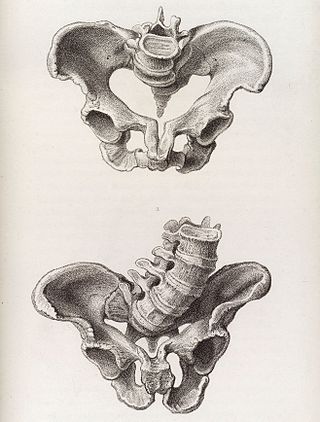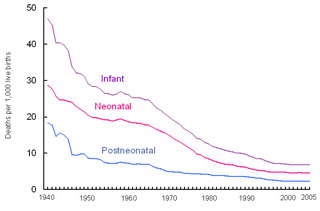Related Research Articles

Cardiomyopathy is a group of primary diseases of the heart muscle. Early on there may be few or no symptoms. As the disease worsens, shortness of breath, feeling tired, and swelling of the legs may occur, due to the onset of heart failure. An irregular heart beat and fainting may occur. Those affected are at an increased risk of sudden cardiac death.

An upper respiratory tract infection (URTI) is an illness caused by an acute infection, which involves the upper respiratory tract, including the nose, sinuses, pharynx, larynx or trachea. This commonly includes nasal obstruction, sore throat, tonsillitis, pharyngitis, laryngitis, sinusitis, otitis media, and the common cold. Most infections are viral in nature, and in other instances, the cause is bacterial. URTIs can also be fungal or helminthic in origin, but these are less common.

A congenital heart defect (CHD), also known as a congenital heart anomaly, congenital cardiovascular malformation, and congenital heart disease, is a defect in the structure of the heart or great vessels that is present at birth. A congenital heart defect is classed as a cardiovascular disease. Signs and symptoms depend on the specific type of defect. Symptoms can vary from none to life-threatening. When present, symptoms are variable and may include rapid breathing, bluish skin (cyanosis), poor weight gain, and feeling tired. CHD does not cause chest pain. Most congenital heart defects are not associated with other diseases. A complication of CHD is heart failure.

Lower respiratory tract infection (LRTI) is a term often used as a synonym for pneumonia but can also be applied to other types of infection including lung abscess and acute bronchitis. Symptoms include shortness of breath, weakness, fever, coughing and fatigue. A routine chest X-ray is not always necessary for people who have symptoms of a lower respiratory tract infection.

Obstructed labour, also known as labour dystocia, is the baby not exiting the pelvis because it is physically blocked during childbirth although the uterus contracts normally. Complications for the baby include not getting enough oxygen which may result in death. It increases the risk of the mother getting an infection, having uterine rupture, or having post-partum bleeding. Long-term complications for the mother include obstetrical fistula. Obstructed labour is said to result in prolonged labour, when the active phase of labour is longer than 12 hours.

Global health is the health of the populations in the worldwide context; it has been defined as "the area of study, research, and practice that places a priority on improving health and achieving equity in health for all people worldwide". Problems that transcend national borders or have a global political and economic impact are often emphasized. Thus, global health is about worldwide health improvement, reduction of disparities, and protection against global threats that disregard national borders, including the most common causes of human death and years of life lost from a global perspective.

Hypertensive heart disease includes a number of complications of high blood pressure that affect the heart. While there are several definitions of hypertensive heart disease in the medical literature, the term is most widely used in the context of the International Classification of Diseases (ICD) coding categories. The definition includes heart failure and other cardiac complications of hypertension when a causal relationship between the heart disease and hypertension is stated or implied on the death certificate. In 2013 hypertensive heart disease resulted in 1.07 million deaths as compared with 630,000 deaths in 1990.

Paratyphoid fever, also known simply as paratyphoid, is a bacterial infection caused by one of three types of Salmonella enterica. Symptoms usually begin 6–30 days after exposure and are the same as those of typhoid fever. Often, a gradual onset of a high fever occurs over several days. Weakness, loss of appetite, and headaches also commonly occur. Some people develop a skin rash with rose-colored spots. Without treatment, symptoms may last weeks or months. Other people may carry the bacteria without being affected; however, they are still able to spread the disease to others. Typhoid and paratyphoid are of similar severity. Paratyphoid and typhoid fever are types of enteric fever.

Disability-adjusted life years (DALYs) are a measure of overall disease burden, expressed as the number of years lost due to ill-health, disability, or early death. It was developed in the 1990s as a way of comparing the overall health and life expectancy of different countries.

Perinatal mortality (PNM) is the death of a fetus or neonate and is the basis to calculate the perinatal mortality rate. Perinatal means "relating to the period starting a few weeks before birth and including the birth and a few weeks after birth."

Acute proliferative glomerulonephritis is a disorder of the small blood vessels of the kidney. It is a common complication of bacterial infections, typically skin infection by Streptococcus bacteria types 12, 4 and 1 (impetigo) but also after streptococcal pharyngitis, for which it is also known as postinfectious glomerulonephritis (PIGN) or poststreptococcal glomerulonephritis (PSGN). It can be a risk factor for future albuminuria. In adults, the signs and symptoms of infection may still be present at the time when the kidney problems develop, and the terms infection-related glomerulonephritis or bacterial infection-related glomerulonephritis are also used. Acute glomerulonephritis resulted in 19,000 deaths in 2013, down from 24,000 deaths in 1990 worldwide.

Disease burden is the impact of a health problem as measured by financial cost, mortality, morbidity, or other indicators. It is often quantified in terms of quality-adjusted life years (QALYs) or disability-adjusted life years (DALYs). Both of these metrics quantify the number of years lost due to disability (YLDs), sometimes also known as years lost due to disease or years lived with disability/disease. One DALY can be thought of as one year of healthy life lost, and the overall disease burden can be thought of as a measure of the gap between current health status and the ideal health status. According to an article published in The Lancet in June 2015, low back pain and major depressive disorder were among the top ten causes of YLDs and were the cause of more health loss than diabetes, chronic obstructive pulmonary disease, and asthma combined. The study based on data from 188 countries, considered to be the largest and most detailed analysis to quantify levels, patterns, and trends in ill health and disability, concluded that "the proportion of disability-adjusted life years due to YLDs increased globally from 21.1% in 1990 to 31.2% in 2013." The environmental burden of disease is defined as the number of DALYs that can be attributed to environmental factors. Similarly, the work-related burden of disease is defined as the number of deaths and DALYs that can be attributed to occupational risk factors to human health. These measures allow for comparison of disease burdens, and have also been used to forecast the possible impacts of health interventions. By 2014, DALYs per head were "40% higher in low-income and middle-income regions."

The Tajikistan health system is influenced by the former Soviet legacy. It is ranked as the poorest country within the WHO European region, including the lowest total health expenditure per capita. Tajikistan is ranked 129th as Human Development Index of 188 countries, with an Index of 0.627 in 2016. In 2016, the SDG Index value was 56. In Tajikistan health indicators such as infant and maternal mortality rates are among the highest of the former Soviet republics. In the post-Soviet era, life expectancy has decreased because of poor nutrition, polluted water supplies, and increased incidence of cholera, malaria, tuberculosis, and typhoid. Because the health care system has deteriorated badly and receives insufficient funding and because sanitation and water supply systems are in declining condition, Tajikistan has a high risk of epidemic disease.

Falling is the action of a person or animal losing stability and ending up in a lower position, often on the ground. It is the second-leading cause of accidental death worldwide and a major cause of personal injury, especially for the elderly. Falls in older adults are a major class of preventable injuries. Construction workers, electricians, miners, and painters are occupations with high rates of fall injuries.

Christopher J. L. Murray is an American physician, health economist, and global health researcher. He is a professor at the University of Washington in Seattle, where he is Chair of Health Metrics Science and the director of the Institute for Health Metrics and Evaluation (IHME).

The Institute for Health Metrics and Evaluation (IHME) is a national and international public health agency and research institute working in the area of global health statistics and impact evaluation, located at the University of Washington in Seattle. IHME is headed by Christopher J.L. Murray, a physician, health economist, and global health researcher, and professor at the University of Washington Department of Global Health, which is part of the School of Medicine. IHME conducts research and trains scientists, policymakers, and the public in health metrics concepts, methods, and tools. Its mission includes judging the effectiveness and efficacy of health initiatives and national health systems. IHME also trains students at the post-baccalaureate and post-graduate levels.
Dean Tecumseh Jamison is an American economist and leader in the study of global health. He is currently Senior Fellow in Global Health Sciences at University of California, San Francisco and an Emeritus Professor of Global Health at the University of Washington in Seattle. He has published in health economics, global health, education economics, and decision theory.
Lidia Morawska is a Polish–Australian physicist and distinguished professor at the School of Earth and Atmospheric Sciences, at the Queensland University of Technology and director of the International Laboratory for Air Quality and Health (ILAQH) at QUT. She is also co-director of the Australia-China Centre for Air Quality Science and Management, an adjunct professor at the Jinan University in China, and a Vice-Chancellor fellow at the Global Centre for Clean Air Research (GCARE), University of Surrey in the United Kingdom. Her work focuses on fundamental and applied research in the interdisciplinary field of air quality and its impact on human health, with a specific focus on atmospheric fine, ultrafine and nanoparticles. Since 2003, she expanded her interests to include also particles from human respiration activities and airborne infection transmission.

Rita V. Krishnamurthi is a New Zealand academic, and since 2023 is a full professor at the Auckland University of Technology, specialising in the epidemiology of stroke and dementia.
References
- ↑ "About GBD". 18 April 2014.
- ↑ "What does a $100 million public health data revolution look like?". TEDMED.
- 1 2 3 "Institute for Health Metrics and Evaluation and World Health Organization sign new agreement" . Institute for Health Metrics and Evaluation. May 2015. Retrieved January 29, 2017.
- ↑ Prüss-Üstün A, Mathers C, Corvalán C, Woodward A (2003). Assessing the environmental burden of disease at national and local levels: Introduction and methods. WHO Environmental Burden of Disease Series. Vol. 1. Geneva: World Health Organization. ISBN 978-92-4-154620-1. Archived from the original on June 12, 2005.
- 1 2 3 4 "About the Global Burden of Disease (GBD) project". Health statistics and health information systems. World Health Organization. Archived from the original on October 27, 2008.
- ↑ "Global burden of disease". World Health Organization.
- ↑ "The global burden of disease: 2004 update" (PDF). World Health Organization. 2008.
- ↑ "Global health risks: mortality and burden of disease attributable to selected major risks" (PDF). World Health Organization. 2009.
- ↑ Global Burden of Disease (GBD) at WHO, 2012
- ↑ "Global Burden of Disease: Massive shifts reshape the health landscape worldwide". Institute for Health Metrics and Evaluation. 2014-05-08. Retrieved January 30, 2017.
That's one of the main findings from the Global Burden of Disease Study 2010 (GBD 2010), a collaborative project led by the Institute for Health Metrics and Evaluation (IHME) at the University of Washington.
- 1 2 3 "History". Institute for Health Metrics and Evaluation. 2014-05-10. Retrieved January 29, 2017.
- ↑ Murray CJ, Vos T, Lozano R, Naghavi M, Flaxman AD, Michaud C, et al. (2013). "Disability-adjusted life years (DALYs) for 291 diseases and injuries in 21 regions, 1990-2010: a systematic analysis for the Global Burden of Disease Study 2010". Lancet. 380 (9859): 2197–223. doi:10.1016/S0140-6736(12)61689-4. PMID 23245608. S2CID 205967479.
- 1 2 Murray CJ, Ezzati M, Flaxman AD, Lim S, Lozano R, Michaud C, et al. (2013). "GBD 2010: design, definitions, and metrics". Lancet. 380 (9859): 2063–6. doi:10.1016/S0140-6736(12)61899-6. PMID 23245602. S2CID 27164993.
- ↑ Watts C, Cairncross S (2013). "Should the GBD risk factor rankings be used to guide policy?". Lancet. 380 (9859): 2060–1. doi:10.1016/S0140-6736(12)62121-7. PMID 23245600. S2CID 40347192.
- 1 2 Rudan I, Chan KY (December 18, 2014). "Global health metrics needs collaboration and competition" (PDF). The Lancet . 385 (9963): 92–94. doi:10.1016/S0140-6736(14)62006-7. PMID 25530441. S2CID 28100116 . Retrieved January 27, 2017.
- 1 2 Doughton S (January 25, 2017). "Historic gift: Gates Foundation gives $279 million to University of Washington". The Seattle Times . Retrieved January 25, 2017.
Initially, though, IHME antagonized other health experts, who accused the Seattle institute of arrogance and failing to share data and methods. Its first global health report card was not acknowledged by the World Health Organization.
- 1 2 3 4 5 6 7 GBD 2013 Mortality and Causes of Death Collaborators (2014). "Global, regional, and national age–sex specific all-cause and cause-specific mortality for 240 causes of death, 1990–2013: a systematic analysis for the Global Burden of Disease Study 2013". The Lancet. 385 (9963): 117–171. doi:10.1016/S0140-6736(14)61682-2. ISSN 0140-6736. PMC 4340604 . PMID 25530442.
{{cite journal}}:|author1=has generic name (help)CS1 maint: numeric names: authors list (link) - ↑ "GBD History". Institute for Health Metrics and Evaluation. 2014-04-18. Retrieved January 30, 2017.
- 1 2 "History". Institute for Health Metrics and Evaluation. 2014-05-09. Retrieved 2020-12-26.
- ↑ "Epic Measures". jeremynsmith.com. Retrieved 2020-12-26.
- 1 2 "Latest GBD results: 2019". IHME. University of Washington. 8 October 2020. Retrieved 9 July 2022.
- 1 2 "Latest GBD results: 2021". TheLancet. Elsevier. 25 May 2024. Retrieved 25 May 2024.
- ↑ "GBD Fact Sheets". IHME. University of Washington. 25 May 2024. Retrieved 25 May 2024.
- ↑ "GBD Results Tool". IHME. University of Washington. 25 May 2024. Retrieved 25 May 2024.
- ↑ Brown D (March 5, 2013). "Web-based tool charts disease, risk factors around the world and through time". The Washington Post . Retrieved January 31, 2017.
- ↑ Das P (2012). "The story of GBD 2010: a "super human" effort". Lancet. 380 (9859): 2067–2070. doi: 10.1016/s0140-6736(12)62174-6 . PMID 23259158. S2CID 45801452.
- ↑ "Increase in global life expectancy offset by war, obesity, and substance abuse". Institute for Health Metrics and Evaluation. 2016-10-03. Archived from the original on 2017-01-25. Retrieved January 29, 2017.
- ↑ GBD 2015 Mortality and Causes of Death Collaborators (2016-10-08). "Global, regional, and national life expectancy, all-cause mortality, and cause-specific mortality for 249 causes of death, 1980–2015: a systematic analysis for the Global Burden of Disease Study 2015". The Lancet. 388 (10053): 1459–1544. doi:10.1016/S0140-6736(16)31012-1. ISSN 0140-6736. PMC 5388903 . PMID 27733281.
- ↑ "Global burden of disease study 2015 assesses the state of the world's health". ScienceDaily . October 6, 2016. Retrieved January 29, 2017.
- ↑ Peter Hotez (November 17, 2016). "Vaccinations, Vaccine Science, and a New US President | Speaking of Medicine". PLOS . Retrieved January 31, 2017.
Those results include new findings just released by the Gates Foundation-supported Global Burden of Disease 2015 Mortality and Causes of Death Collaborators that found a 75 percent reduction in global measles mortality over the last decade such that (for the first time ever) fewer than 100,000 children died from measles in 2013 and 2015
- ↑ "Table 3: Selected causes of global child deaths in 1990 and 2013" . Retrieved January 31, 2017.
- ↑ "Table 5: Global deaths in 2005 and 2015 for all ages and both sexes combined and age-standardised death rates, with percentage change between 2005 and 2015 for 249 causes" . Retrieved January 31, 2017.
- ↑ Nisha Gaind (July 25, 2016). "Global rate of new HIV infections hasn't fallen in a decade". Nature. doi:10.1038/nature.2016.20305. S2CID 78940073 . Retrieved February 2, 2017.
- ↑ "Global Burden of Disease Study 2015 (GBD 2015) Socio-Demographic Index (SDI) 1980–2015". GHDx. Institute for Health Metrics and Evaluation . Retrieved February 7, 2017.
- ↑ Myers J (September 23, 2016). "There's a new ranking of the healthiest countries. How is yours doing?". World Economic Forum . Retrieved February 7, 2017.
- ↑ Lancet T (2016-10-08). "GBD 2015: from big data to meaningful change". The Lancet. 388 (10053): 1447. doi:10.1016/S0140-6736(16)31790-1. ISSN 0140-6736. PMID 27733277. S2CID 33167967 . Retrieved 2017-02-07.
- ↑ Edward Wong (August 17, 2016). "Coal Burning Causes the Most Air Pollution Deaths in China, Study Finds". The New York Times . Retrieved January 31, 2017.
- ↑ "Roads Kill: The toll of traffic accidents is rising in poor countries". The Washington Post . January 13, 2014. Retrieved January 31, 2017.
- ↑ Dylan Matthews (March 13, 2015). "The #1 reason people die early, in each country". Vox. Retrieved January 31, 2017.
- ↑ Neal Emery (January 24, 2013). "How the World Gets Sick and Dies". The Atlantic . Retrieved January 31, 2017.
- ↑ Olga Khazan (October 7, 2016). "How Back Pain Took Over the World". The Atlantic . Retrieved January 31, 2017.
- ↑ "Global Burden of Disease (GBD 2019)". Institute for Health Metrics and Evaluation. 2014-03-17. Retrieved 2020-12-26.
- ↑ "Research Articles – Project: Global Burden of Diseases, Injuries, and Risk Factors Study (GBD)". Institute for Health Metrics and Evaluation . Retrieved February 2, 2017.
- ↑ "Lancet Global Burden of Disease". The Lancet . Retrieved February 3, 2017.
- ↑ "Lancet Global Burden of Disease Study 2013". The Lancet . Retrieved February 3, 2017.
- ↑ "Lancet Global Burden of Disease Study 2010". The Lancet . Retrieved February 3, 2017.
- ↑ Murray CJ, Lopez AD. "Search Results for: The Global Burden of Disease and Injury". Harvard University Press. Retrieved February 3, 2017.
- ↑ Christopher J. L. Murray, Alan D. Lopez, eds. (1998). Health dimensions of sex and reproduction: the global burden of sexually transmitted diseases, HIV, maternal conditions, perinatal disorders, and congenital anomalies. World Health Organization. hdl:10665/42161. ISBN 0-674-38335-4.
- ↑ Christopher J. L. Murray, Alan D. Lopez (1996). Global health statistics: a compendium of incidence, prevalence and mortality estimates for over 200 conditions. World Health Organization. hdl:10665/41848. ISBN 0-674-35449-4.
- ↑ Christopher J. L. Murray, Alan D. Lopez, eds. (1996). WHO IRIS: The Global burden of disease : a comprehensive assessment of mortality and disability from diseases, injuries, and risk factors in 1990 and projected to 2020: summary. World Health Organization. hdl: 10665/41864 . ISBN 0-9655466-0-8.